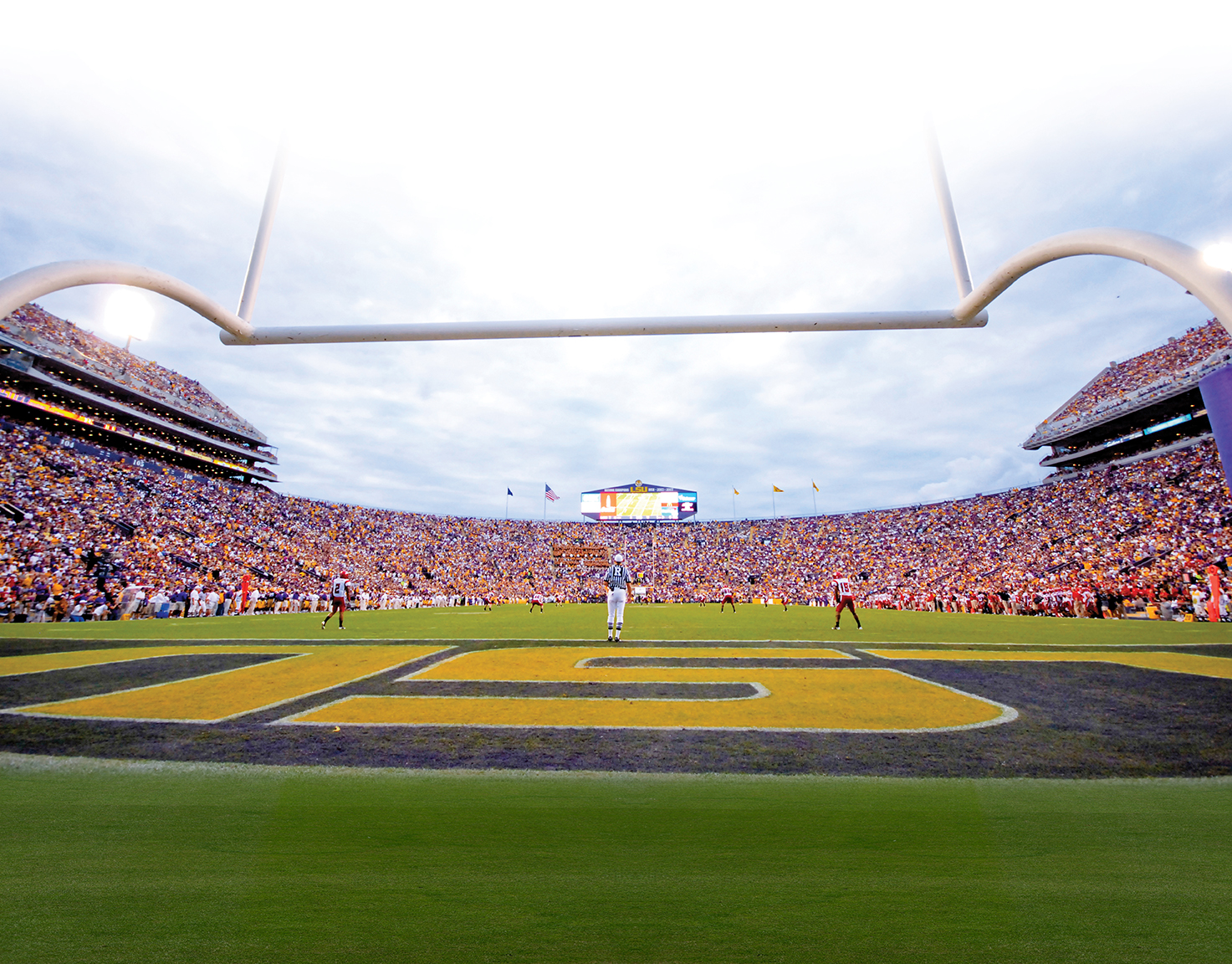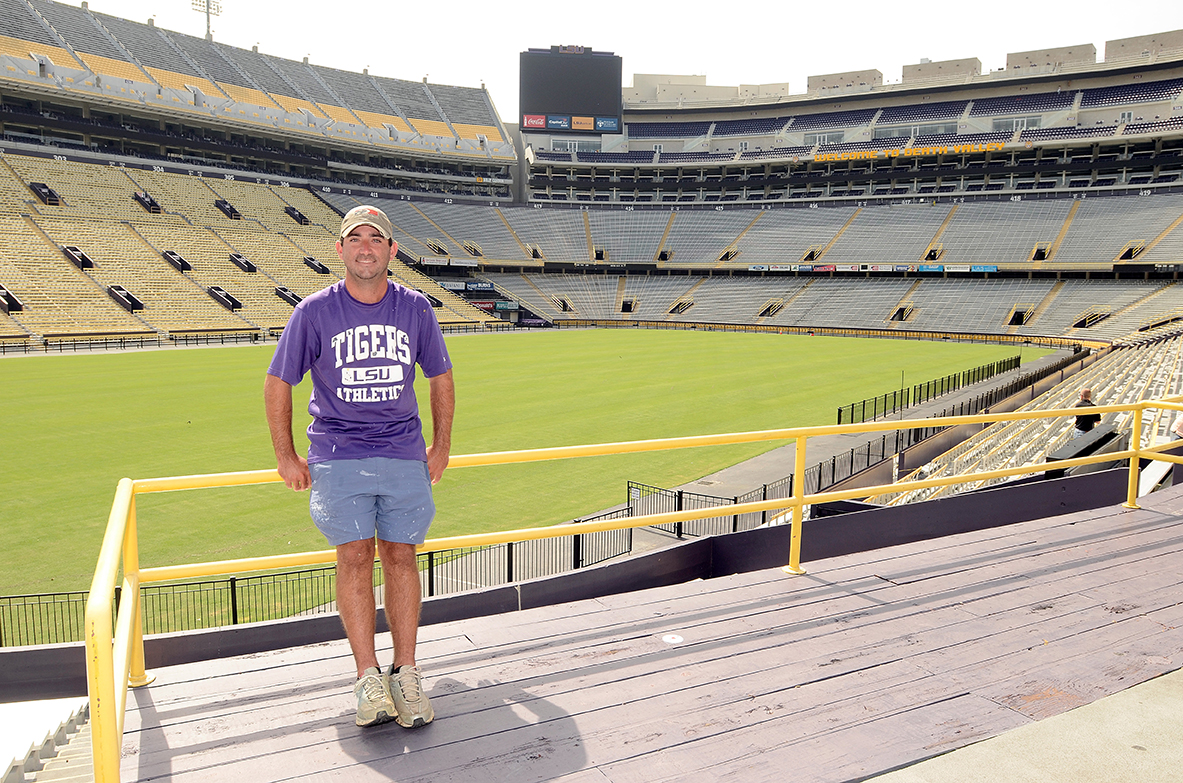
Tiger Stadium: Field of Dreams
Photo by David Gallent
How field caretakers make it one of the best places to play football in the country
By Mark Clements
There aren’t many fields in college football that are put under the spotlight as much as the turf in Tiger Stadium.
It has to look crisp and colorful for national television. It has to hold up well for the players who abuse it each week. Heck, it even has to taste good for Les Miles when he decides to have a mid-game snack.
|
|
It’s not often the focus of the hundreds of thousands of LSU fans on Saturday nights, but the grass in Tiger Stadium is scrutinized just as carefully as the team it houses.
And just like the football program, which many say has no off-season, the grounds crew at LSU works year-round to preserve the pristine look of the iconic field.
“There’s a bunch of stuff we’ve got to do to the field before we can even think about playing football,” says LSU assistant sports turf manager Hunter Sexton.
And it all begins months before kickoff in September.

Springtime maintenance
The process restarts yearly in late May, once Bayou Country Superfest comes to a close.
LSU brings in between nine and ten 18-wheelers worth of Celebration Bermuda grass—which Miles specifically asked for upon his arrival in 2005—from Pine Creek Turf in Adel, Georgia.
Studies done by several universities across the Southeast show that Celebration Bermuda is rated as the top sod for shade tolerance, wear tolerance and divot recovery, as well as drought tolerance and recovery, according to its website.
“They grow it specifically for Tiger Stadium,” Sexton says. “When [Les] came in, he wanted the field to play fast and firm. Basically, what we do is we get it real smooth by top-dressing the sand, and we cut it at 5/8 [of an inch]. That’s short. That allows the players to play a lot faster. It’s like when you’re playing on concrete, you can run a lot faster than you could on [tall] grass. It’s just that little bit extra.”
Once the sod is set, Sexton and staff will take a couple weeks to water it, letting it grow and root properly before beginning the final touches.
The first mow of the year comes about two weeks later, once the grass is fully rooted. The grounds crew then cuts the stolons (horizontal stems grass uses to grow), top-dresses it twice and lets it properly aerate by poking holes and pulling cores.
Top-dressing the grass means pouring sand on the field to even it out, “so it’ll be a lot smoother and play a lot faster,” Sexton says.
They’ll then roll the field using giant rollers to remove any undulations and flatten the playing surface, while continuing to mow and fertilize the grass throughout the summer.

Summer prep
By now, football season is fast approaching, but that doesn’t mean Sexton’s job slows down at all.
“Once we’re done with all that and all we’re doing is mowing and fertilizing, we’ll put the goal posts up,” Sexton says. “Once the goal posts go up, we’re able to get our field markings down.”
That process is easier said than done.
The grounds crew manually carries each heavy goal post into its proper position and bolts down the base with four large screws on each side.
The pair of uprights is two separate pieces that extend 40 feet into the air and require a lift to be accurately lowered onto the top of the crossbar.
“We just get a bunch of our guys, and we just lift them up and walk them over there,” Sexton says. “We’ll have a bunch of guys on [each] post and a couple guys with Y-joints to help push it up. Once they’re up, we won’t take the goal posts down until after Spring Game.”
Upkeep during the season
The final task to prep the field also seems like one of the most daunting—painting.
The initial base coat of paint is laid down in August, but once the season starts, painting is a three- to four-day process that will take them all the way up until the Friday before a Saturday game to finish.
Between the endzones, the yard markers and the midfield logo, the grounds crew will go through a whopping 120 gallons of paint each week during the season, pretty evenly distributed between purple, gold and white coloring.
The LSU endzone letters, SEC logos and yard numbers are painted with a stencil, but amazingly enough, the trademark tiger eye at midfield is predominately done by freehand.
“We have a couple measurements that we put down at midfield, and we have little dots around that,” Sexton says. “Then we just look at old pictures and try to connect the dots. It’s pretty much [freehand]. Of course week one, we always think the tiger eye looks good, but then we’ll go through a couple weeks, and we’ll try to situate it or move it a little bit to try to make it longer and more like the actual logo. If you look at it, I swear to you it changes a little bit every week.”
The weekly maintenance of Tiger Stadium’s turf during football season is relatively routine, but it’s still a delicate process.
As soon as a game ends, Sexton is out on the mower cutting the grass yet again.
Sunday is a day of rest for the field, but the crew is back at work Monday morning, filling divots and giving it another mow—one of five cuts it will receive during the week.
This process is repeated every week of the season and all through the spring (minus the painting) until Bayou Country Superfest rolls around, which requires the removal of the sod.
The broken-in field won’t go to waste, though. The crew transports the old grass to the football practice facility each spring, to keep the players accustomed to the gameday feel.
|
|
|

